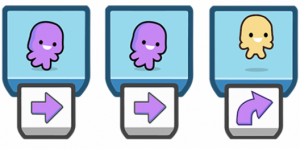If you are one of the many parents managing the responsibilities of working at home while also taking care of your children, you’re not alone. Code-themed education can help your kids learn useful skills like touch typing, processing, and creative coding. You can give your kids a new and exciting way to stay occupied with the help of these several resources and applications that can teach them how to code.
Scratch Jr– Scratch Jr is a free app designed to teach younger children between the ages of 5-7 how to code. Kids can program their own interactive games and stories before watching them come to life using programming blocks.
We 💕 a week full of FUN #Coding!
Follow #ScratchWeek exploring @scratch & @ScratchJr #online and #offline #STEM coding!#ScienceWorldca Educators have fav projects they've posted, including a Spring Greeting card:https://t.co/2r8motOVey#ADST #STEAM #bced #STEMeducation pic.twitter.com/NQN73P245F
— Science World Teacher Resources (@ScienceWorldTR) May 20, 2021
Hour of Code from Code.org– The Hour of Code started as a one-hour introduction to computer science that was designed to demystify “code” and show that anyone could learn the basics of computer programming. It has become a worldwide effort to celebrate computer science, starting with 1-hour coding activities and expanding to all sorts of community efforts. Parents can make Hour of Code a weekly activity with their children, and even host an event with friends.

Stencyl– This app is available on Android and Apple devices. Stencyl allows kids of all ages to create and publish their own games by learning programming skills. It teaches game logic through a drag and drops interface and world-building.

Hopscotch– This free app is great for kids ages 7-13, but can be used by anyone wanting to learn how to code. Hopscotch has self-paced video tutorials that teach coding through popular games like Pokemon Go and Geometry Dash.
GoldieBlox– If you’re looking for a hands-on approach to storytelling and STEM, GoldieBlox uses videos, animation, curriculum, and more to teach girls about science, technology, engineering, and math. You can help your child build a light-up unicorn pillow or a do-it-yourself (DIY) mermaid cell phone case and more!
Go Tynker– Using blocks, Go Tynker is a free iPhone/iPad app that assists kids from grades 1st-8th with learning coding in an interactive way. By completing lessons, kids earn badges to reward their progress.
As a starting point here are some tips for teaching kids how to code: Challenge Kids Ideas of Computers
- Start off the conversation by asking, “What is a computer?”. Then have a couple of pictures of household items that include different types of computers or technology like a self-flushing toilet, sprinklers, or even pets.
- Ask your kids to identify which of the photos are computers. When they look baffled, explain that all of these examples are computers. For example, the toilet has sensors that detect motion and communicate for the device to flush and sprinklers are set on a timer to go off on certain days at certain times.
- Even pets can be considered a computer if they have microchips in their skin that store home addresses and contact information. By using examples they understand, parents can make computers and technology seem more interesting and something they can engage with daily.
These exercises challenge the perception that computers are just rectangular boxes with screens. With today’s technology and the emerging Internet of Things (IoT), anything can be a computer! Being on the computer can be a fun, educational, and immersive experience for a child as they learn how to focus, analyze, and train their brain with new skill. Change up their routine using these amazing resources that can keep them entertained for hours.









